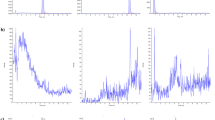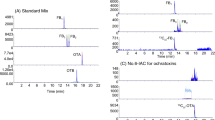Abstract
Sixty six samples of red and white wine from Ontario (VQA), British Columbia (VQA), Québec (“vins artisanaux”), imported wines (from Italy, South America and USA) and Canadian and US grape and cranberry juices were analysed for theAlternaria mycotoxins alternariol (AOH) and alternariol monomethyl ether (AME). After cleanup on aminopropyl SPE columns, AOH and AME were initially determined by reversed phase LC with UV detection. Positive sample extracts were re-analysed by LC-tandem negative ion electrospray mass spectrometry (MS/MS) in multiple reaction mode. Overall mean method recoveries measured by LC-UV were 93% for AOH and 81% for AME. Limits of detection in wine (and juice) by LC-UV for AOH were 0.8 (0.4) ng/ml and for AME were 0.5 (0.4) ng/ml; they were below 0.01 ng/ml by LC-MS/MS. As determined by LC-MS/MS, AOH was found in 13/17 Canadian red wines at levels of 0.03 to 5.02 ng/ml and in 7/7 imported red wines at 0.27–19.4 ng/ml, usually accompanied by lower concentrations of AME. Red grape juices (5 positive/10 samples) contained only sub ng/ml levels of AOH or AME except for one sample (39 ng AME/ml). White wines (3/23 samples), white grape juices (0/4 samples) and cranberry juices (1/5 samples) contained little AOH/AME (≤1.5 ng/ml).
Similar content being viewed by others
References
Chełkowski J, Visconti A (eds) (1992)Alternaria. Biology, Plant Diseases and Metabolites Elsevier, Amsterdam
Kwasna H (1992) Ecology and nomenclature ofAlternaria. In: Chełkowski J, Visconti A (eds)Alternaria: Biology, Plant Diseases and Metabolites, Elsevier, Amsterdam, 63–100
Medina A, Mateo R, López-Ocaña, L, Valle-Algarra FM, Jiménez M (2005) Study of grape mycobiota and ochratoxin A production by isolates ofAspergillus tubingensis and other members ofAspergillus sectionNigri. Appl Environ Microbiol 71: 4696–4702
Serra R, Braga A, Venâncio A (2005) Mycotoxin-producing and other fungi isolated from grapes for wine production, with particular emphasis on ochratoxin A. Res Microbiol 156: 515–521
Tournas VH, Katsoudas E (2005) Mould and yeast flora in fresh berries, grapes and citrus fruits. Int J Food Microbiol 105: 11–17
Stiles CM, Oudemans PV (1999) Distribution of cranberry fruit-rotting fungi in New Jersey and evidence for nonspecific host resistance. Phytopathology 89: 218–225
Tournas VH, Stack ME (2001) Production of alternariol and alternariol methyl ether byAlternaria alternata grown on fruits at various temperatures. J Food Protect 64: 528–532
Scott PM (2001) Analysis of agricultural commodities and foods forAlternaria mycotoxins. J AOAC International 84: 1809–1817
Combina M, Dalcero A, Varsavsky E, Torres A, Etcheverry M, Rodriguez M, Gonzalez Quintana H (1999) Effect of heat treatments on stability of alternariol, alternariol monomethyl ether and tenuazonic acid in sunflower flour. Mycotoxin Research 15: 33–38
Schrader T J, Cherry W, Soper K, Langlois I, Vijay H M (2001) Examination ofAlternaria alternata mutagenicity and effects of nitrosylation using the AmesSalmonella test. Teratogen Carcinogen Mutagen 21: 261–274
Yekeler H, Bitmiş K, Özçelik N, Doymaz MZ, Çalta M (2001) Analysis of toxic effects ofAlternaria toxins on esophagus of mice by light and electron microscopy. Toxicol Pathol 29: 492–497
Lau BP-Y, Scott PM, Lewis DA, Kanhere SR, Cléroux C, Roscoe VA (2003) Liquid chromatography-mass spectrometry and liquid chromatography-tandem mass spectrometry of theAlternaria mycotoxins alternariol and alternariol monomethyl ether in fruit juices and beverages. J Chromatogr A 998: 119–131
Scott PM, Kanhere SR (2001) Stability ofAlternaria toxins in fruit juices and wine. Mycotoxin Research 17: 9–14
Bellí N, Marín S, Sanchis V, Ramos AJ (2002) Review: ochratoxin A (OTA) in wines, musts and grape juices: occurrence, regulations and methods of analysis. Food Sci Technol Int 8: 325–335
Author information
Authors and Affiliations
Corresponding author
Rights and permissions
About this article
Cite this article
Scott, P.M., Lawrence, G.A. & Lau, B.P.Y. Analysis of wines, grape juices and cranberry juices forAlternaria toxins. Mycotox Res 22, 142–147 (2006). https://doi.org/10.1007/BF02956778
Issue Date:
DOI: https://doi.org/10.1007/BF02956778




